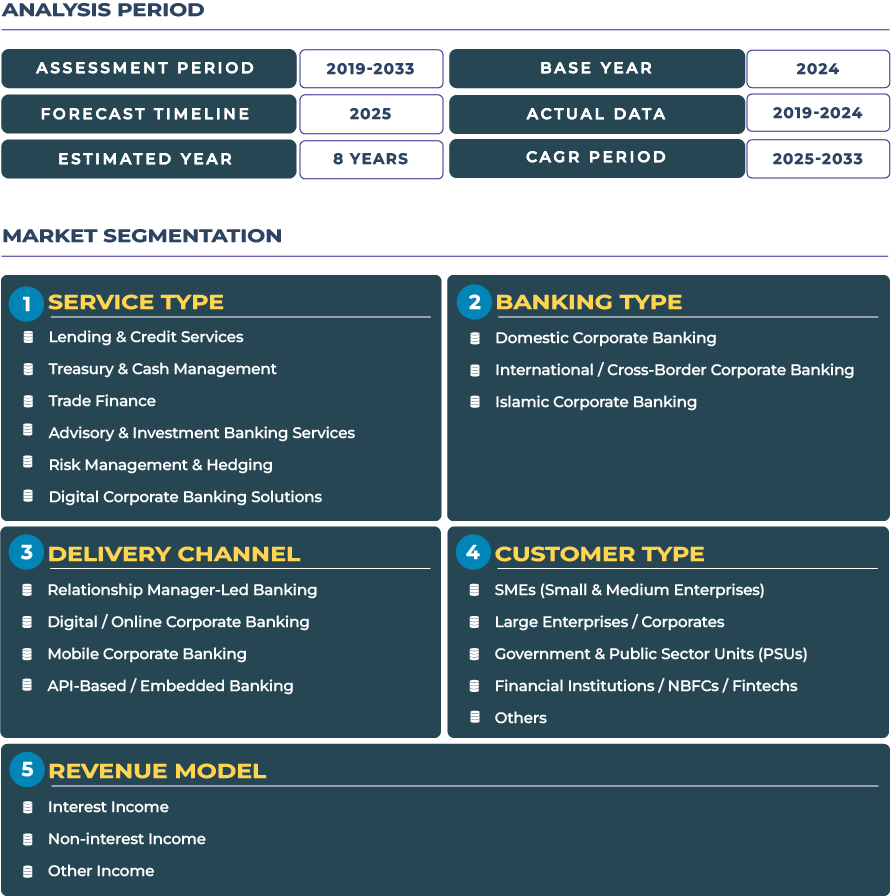High-Tech Corporate Banking Services in Japan: Automating Treasury and Cash Management Solutions
Japan corporate banking sector stands at the forefront of technological transformation, integrating automation, robotics, and advanced analytics into treasury and cash management operations. As Japanese enterprises expand globally, banks are modernizing their platforms to deliver high-speed, low-risk financial management solutions that align with the nation’s manufacturing and export-driven economy. With automation redefining transactional workflows, liquidity management, and forecasting, Japan corporate banking market continues to adapt to the demands of digital maturity and precision finance.
Note:* The market size refers to the total revenue generated by banks through interest income, non-interest income, and other ancillary sources.
According to DataCube Research, the Japan Corporate Banking Market is projected to grow from USD 90.5 billion in 2025 to USD 113.2 billion by 2033, reflecting a steady CAGR of 2.8%. The market’s resilience is underpinned by the country’s financial stability, high digital infrastructure penetration, and corporate demand for efficiency in treasury management. This growth underscores Japan’s balance between traditional relationship-driven banking and the pursuit of digitally optimized operations, making it one of the most technologically integrated corporate banking markets globally.
Strategic Market Drivers Shaping the Japan Corporate Banking Landscape
Japan corporate banking growth is driven by structural and technological imperatives. Major corporations, particularly in automotive, electronics, and heavy manufacturing, require precision cash management systems to coordinate operations across complex supply chains. Institutions such as Bank of Japan and leading lenders are increasingly focused on enabling intraday liquidity and automated reconciliation services that reduce operational bottlenecks for multinational clients.
Another key driver is the stability-oriented nature of Japanese corporates. Many enterprises with conservative risk appetites prefer long-term partnerships with established banks, leading to sustained demand for stable credit facilities and liquidity products. Trade finance remains a central pillar of growth, especially for exporters leveraging yen- and dollar-denominated instruments to manage foreign currency exposure. Furthermore, Japan’s renewed emphasis on green transition financing and energy efficiency upgrades in industrial sectors is creating strong lending opportunities across ESG-linked instruments.
Key Market Restraints and Challenges Facing Corporate Banks
Despite steady growth, the Japan corporate banking industry faces structural headwinds. Decades of low interest rates have constrained net interest margins, compelling banks to depend heavily on fee-based services rather than traditional lending profitability. Additionally, the slow adoption of fintech partnerships among large corporations has limited the agility of banks to roll out fully digital corporate solutions.
Legal and regulatory complexities also hinder progress. Japan’s corporate structure, particularly among keiretsu conglomerates, often complicates group cash pooling and intercompany funding due to cross-entity ownership and regulatory oversight. This reduces the flexibility of banks to provide consolidated liquidity solutions. Moreover, demographic challenges, an aging workforce and slow SME digitization, pose a risk to future innovation within the banking ecosystem, requiring continuous policy support from financial authorities.
Emerging Trends and Market Opportunities in Japan Corporate Banking Ecosystem
Japan is witnessing a paradigm shift in how corporations and banks collaborate on treasury automation. A defining trend is the integration of corporate ERP systems directly with bank APIs, allowing real-time transaction visibility and cash flow control. As manufacturers digitalize their operations, demand for automated payments, AI-powered forecasting, and predictive liquidity management tools is surging.
Another trend shaping the Japan corporate banking sector is the focus on supply chain resilience finance. After the pandemic-induced disruptions, banks are creating dedicated programs for financing inventory buffers and supplier diversification, ensuring operational continuity for clients. Simultaneously, ESG-linked corporate lending is expanding, with banks aligning credit lines to environmental and carbon reduction goals. Opportunities such as factory digitalization finance and green capital expenditure loans have gained momentum, supported by government incentives for sustainable industrial transformation.
Competitive Landscape: Japan’s Major Corporate Banking Institutions Innovating for the Future
The competitive ecosystem of Japan corporate banking market is defined by the dominance of leading financial groups such as Mizuho Financial Group, Sumitomo Mitsui Financial Group, and MUFG Bank. These institutions continue to expand their technological edge through investments in digital platforms, cross-entity liquidity services, and corporate treasury modernization tools.
Key strategic initiatives include the creation of group-wide cash pooling and cross-entity liquidity frameworks that optimize working capital efficiency across complex corporate structures. Leading banks are also prioritizing supply chain resilience financing for export-driven manufacturers, helping mitigate global supply disruptions. In addition, ESG-focused lending portfolios are being introduced to align with Japan’s 2050 decarbonization targets, signaling a structural transformation in corporate credit allocation. The combination of these strategies reinforces the market’s competitive edge while enhancing financial stability in the broader corporate ecosystem.







